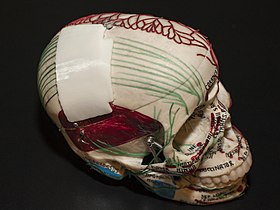| Cranioplasty | |
|---|---|
 3D-printed prosthesis for cranioplasty | |
| ICD-9-CM | 02.0 |
Cranioplasty is a surgical operation on the repairing of cranial defects caused by previous injuries or operations, such as decompressive craniectomy. It is performed by filling the defective area with a range of materials, usually a bone piece from the patient or a synthetic material. Cranioplasty is carried out by incision and reflection of the scalp after applying anaesthetics and antibiotics to the patient. The temporalis muscle is reflected, and all surrounding soft tissues are removed, thus completely exposing the cranial defect. The cranioplasty flap is placed and secured on the cranial defect. The wound is then sealed.[1]
Cranioplasty was closely related to trephination, and the earliest operation is dated to 3000 BC.[2] Currently, the procedure is performed for both cosmetic and functional purposes. Cranioplasty can restore the normal shape of the skull and prevent other complications caused by a sunken scalp, such as the "syndrome of the trephined".[3] Cranioplasty is a risky operation, with potential risks such as bacterial infection and bone flap resorption.[4]
- ^ Piazza M, Grady MS (April 2017). "Cranioplasty". Neurosurgery Clinics of North America. 28 (2): 257–265. doi:10.1016/j.nec.2016.11.008. PMID 28325460.
- ^ Sanan A, Haines SJ (March 1997). "Repairing holes in the head: a history of cranioplasty". Neurosurgery. 40 (3): 588–603. doi:10.1097/00006123-199703000-00033. PMID 9055300.
- ^ Dujovny M, Aviles A, Agner C, Fernandez P, Charbel FT (March 1997). "Cranioplasty: cosmetic or therapeutic?". Surgical Neurology. 47 (3): 238–41. doi:10.1016/s0090-3019(96)00013-4. PMID 9068693.
- ^ Acciarri N, Nicolini F, Martinoni M (December 2016). "Cranioplasty: Routine Surgical Procedure or Risky Operation?". World Journal of Surgical Research. 5 (5).